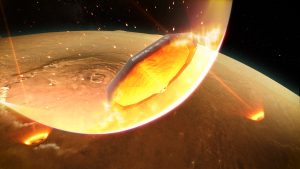
Global space news: NASA’s InSight Mission peers inside Mars
“Marsquakes” detected by NASA’s Insight Mission have revealed the internal structure of the red planet. Earthquakes and marsquakes are examples of seismic waves that are triggered by a sudden fracture in the planet’s rock. As these waves roll through the planet, they reflect off boundaries where the interior environment changes, such as at the edge of the planet’s iron rich core. Detecting these reflections reveals the existence and size of the different regions below Mars’s surface.
Peering inside a planet is incredibly useful for understanding the planet’s formation and evolution. Insight has revealed Mars has a large core, thin mantle and crustal density that points to a different composition compared to the Martian surface. This data can be used to model the evolution of Mars, which is essential to understand the prospects for early habitability and the potential divergent routes for rocky worlds.
The history of Mars is a particularly important comparison for JAXA’s Martian Moons eXploration (MMX) mission, which will return a sample from Mars’s moon, Phobos, in 2029. The sample will contain information both on the formation of the Martian moons, and the evolution of Mars’s surface through grains ejected from Mars that have landed on the closely-orbiting Phobos. Both are intricately connected with how Mars developed.
But if the inner workings of planets are key to understanding their history, what are the prospects for seeing inside other celestial bodies?

Like the InSight team, Professor Shiraishi Hiroaki is working on a seismograph. The instrument’s destination is not Mars, but the Saturn moon, Titan, onboard the NASA-led Dragonfly mission. Speaking of the InSight results, Shiraishi comments,
It is a historical achievement to reveal the internal structure of planets other than the Earth using seismological methods. In future planetary exploration, the exploration of internal structure will be realised for steadily more worlds. The same observation technique can be applied to the large icy moons that are thought to host an interior sea. The Saturn moon, Titan, is one example, with the seismograph we are developing at JAXA for NASA’s Dragonfly mission will play a key role in exploring beneath the surface.
Shiraishi Hiroaki, Department of Solar System Science
While the success of InSight is promising for future Titan data, the Dragonfly seismograph will have to contend with incredibly cold temperatures on the icy moon.
Returning to the Martian sphere, Dr Liang Yuying has a different idea for measuring the innards of the Martian moons. She plans use how the orbit of the MMX spacecraft is influenced by the gravity of Phobos to estimate a likely structure for the moon’s interior.
Apart from scratching a celestial body apart, we are almost able to ‘read’ its interior from accurate data about the orbit of the flying spacecraft! Data about the Martian moon, Phobos, will be gathered by the MMX spacecraft when it visits this target in 2025! It will be journey we take together with the MMX spacecraft!
Liang Yuying, JSPS Postdoctoral Fellow, Department of Solar System Sciences
In addition to these ideas, JAXA is also considering plans for deploying multiple seismometers on the lunar surface, utalising previously developed technology for a new broadband seismometer. Together, these concepts are allowing us to embark on a new stage of planetary exploration, where we seek to understand planets right to their core.
“Global space news” is a chance for us to highlight important developments across the world and share our excitement of these achievements.
Further information:
InSight mission news
The Martian Moons eXploration Mission website
Cosmos: Measuring the waves through Titan


 Previous Post
Previous Post Next Post
Next Post






